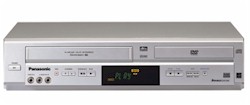How to Buy a DVD Player
DVD players offer picture clarity and sound quality that clearly surpasses VCRs. In addition, the disks are smaller and can last longer than VHS tapes. As a result, buying a DVD player is one of the easiest and least expensive ways to significantly improve your home video experience.
 |
 |
| Shown above, Sony DVD player (left) and Panasonic DVD / VCR combo (right) | |
Types of DVD Players
- Single tray DVD or DVD Changer - single DVD players are a good choice for someone who wants to use the DVD player primarily for watching movies. If you plan to use the unit significantly as a CD player, you may want to consider a multi-disk carousel unit that can shuffle through songs.
- DVD/VCR Combo - if space is limited, consider a combination unit that can play both DVDs and VHS tapes.
- DVD Recorders - record directly onto a blank DVD. DVD recorders cost significantly more than play-only DVD players. If you plan to record tv shows or movies a recorder may make sense. If you plan to record DVDs from a camcorder, it may make more sense to buy a DVD recorder for you PC, they are generally less expensive and provide better editing capabilities.
- Portable Units - small DVD players with built-in screens, usually have battery or AC plugs. Many can connect to regular TVs for large screen viewing.
- Muti-Regional Units - DVD disks are encoded with a regional code, 1 for the US and Canada; 2 for Europe, Japan and South Africa; 3 for South-East Asia; 4 for Latin America, Australia and New Zealand; 5 for Russia and the rest of Africa and Asia, and 6 for China. This is a well-intentioned attempt by the motion picture industry to curb abuses of their copyrights. However, if you travel frequently between different regions, viewing your DVDs can be difficult. It is possible to buy a DVD player that can play DVDs from multiple regions, but the legality of these players is often questionable.
- Slim Chassis - some DVD players have a design that reduces the front height to as little as 2 inches
DVD Attributes
- Surround Sound - most DVD players can connect to your home theater receiver to provide surround sound. Most DVD players don't have surround sound decoders, they simply output the signal as encoded on the DVD. There are two types coaxial digital input and optical digital input.
- Additional Formats - Besides playing movies, many DVD players can also play audio CDs, and digital photos or MP3 files recorded on CD-RW
- Hook-up - there are several types of possible ways to connect a DVD player to a TV or home entertainment system
- Coaxial (or RF)- One cable-type connection from the VCR to the TV, provides both video and audio signals. This type of hook-up is the most vulnerable to interference.
- Composite - usually a Yellow plug for video a Black Plug, and a White Plug for audio. Composite video is usually better than a coaxial connection, but may have some blurring in the video
- S Video - a superior connection than composite video. It separates the video into black and white and color, providing crisper images
- Component - the best connection currently available. It splits the color picture into its components (Red, Green and Blue)
- Front A/V inputs - allow easy connection for digital camera, camcorder or video game
- Progressive Scan - a system that can effectively double the picture resolution when connected to a digital TV (High Definition - HDTV). Progressive scan provides no improvement in picture quality when connect to a conventional TV
- SACD and DVD-Audio - audio CDs with higher resolution and 2 to 6 channel sound.
- Multi-brand Remote - controls multiple devices from multiple manufacturers, e.g. TV, VCR, Home Theater Receiver, etc.
How to Choose
Most DVD players offer excellent sound and picture quality. They differ in their ease of use, functions, and video outputs.
- Determine the type of DVD player you need, a single disk v. multi-disk, dvd or dvd/vhs combo, etc.
- Compare specific models within your price range, specifically looking at:
- TV Connection - make sure the DVD player has the hook-up connections that work / work best with your TV. If your TV is older, it may only have an RF input. If the DVD player does not have a RF output, you can buy a converter for around $30. If your TV has component inputs, you may want to consider spending a little more to get a player with component outputs.
- Surround Sound - if you have a home theater system, make sure the units have the appropriate surround sound outputs
- Ease of Use - look at a DVD players front panel and remote. Does it look logically laid out? If possible, take the unit for a "test drive." Are the controls easy to use? Are the control menus easy to use?
